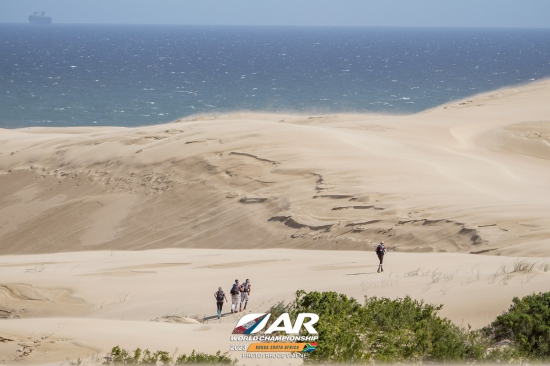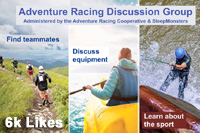Footsteps in the Sand – Day One at ARWC2023
Press Release / 19.10.2023


Day one at the Adventure Racing World Championship was a memorable mix of excitement at the start of the long dreamt of race and a trademark Expedition Africa course through spectacular and contrasting African landscapes.
After the early morning bus ride teams were delivered to TA1 in the small coastal town of Colchester, on the edge of the Addo National Park. There was a 2 hour stop here in which they had to unpack and prepare their bikes, and mark up the maps for stage one.
The buses unloaded outside the Cannonville Slipway and teams entered a large grassy compound containing a huge marquee tent covering rows of map tables, and long lines of bike racks – a sight never seen at an adventure race before. It looked like the transition for a major triathlon.
All of the bike boxes were lined up ready to be collected and the racks soon began to fill up, but a few teams were having last minute problems.
JD Eskelson of team Aventura Avonturr Aventure was having big problems. His bike had been damaged in transit but he’d ridden it to the flag parade and though all was OK. Now the tool releasing his rear axle had snapped, leaving the broken end in the socket. A local supporter helped to get it out after fetching his drill, but the axle was still stuck, under huge torque and couldn’t be released.
The race mechanics will take a look before he finishes the first trekking leg and needs to ride it, but the outcome is uncertain. JD is one of the most experience racers in the ARWS and was looking confounded. “In all my days racing I’ve never seen anything like it,” he said.
The map tent was a hive of activity as well. In this race all teams must mark their maps from master maps, which they will do as they get new maps at each Transition. Quickly, the tables were filled with intent navigators leaning over them, their own maps and marker pens in hand and brows furrowed. It was a scene of intense focus and concentration.
Many, perhaps most, of the teams were surprised by the location of the transition and the start, as they’d looked at the 6 hours between catching the bus and starting and thought they would be much further way from Cape St. Francis.
Clinton Mackintosh of Cyanosis, who is now racing a pair with Grant Ross after the team had injury problems, said, “I was surprised when I saw we were coming to the Addo Area, as it’s not easy to get access to the park, but it’s a great place to start!”
The day was already getting hot and teams sat in the shade of an avenue of trees and took the chance to get food and coffee at the stalls set up for the race.
The start was a further 30 minute drive to get to Oakly Farmsdorp where teams walked up from farm shop and cafe to a flag-decked start line on the hillside across the road. As always as Expedition Africa the start looked amazing and timing was perfect with teams arriving and only a short delay before Heidi Muller began the countdown and set the teams off.
107 international teams ran, or walked, in the hot sun up the steep climb to a ridge top and began the 2023 Adventure Racing World Championship.
The first 56km trek would take them the rest of the daylight hours and for the slower teams most of the night time hours as well, and it was a trek of huge contrasts.
The early stages passed through dairy farmland and stands of native bush, and the pasture and hillsides were lush and green after the recent rains and floods. (The weeks of rain and floods have changed the nature of the course considerably.) Team Brazil Multisport said the country and climate felt like home!
The second part of the trek was entirely different, in every way, as teams reached the ocean and the coastal part of the Addo National Park. Now teams were trekking though huge sand dunes and racing along one of the most stunning coastlines in the world. They were privileged to be in an area few get to visit but the 20km beach trek would test them.
Race Director Stephan Muller said, “Normally the area is closed and it is one of the biggest dune fields in the world. We know teams won’t like the long beach trek but we want to give them a real test early in the race and it is such a special place.”
The coastal wind which seems ever-present here was strong and fortunately right behind the racers, whipping up the sand and stinging their legs and arms on the dune tops. The teams stayed on the firmer ground of the tide line where they could, close to the huge breakers that combined with the wind to give the unique landscape its own soundtrack. The footprints the teams left in the sand were wiped away quickly by the wind and tide after their passing.
The beach stage came to an end at the mouth of the Sundays River, where teams turned inland along the river bank to reach CP15 (relocated a bit further inland due to flood and storm damage). Here they waded and swam the broad river before collecting another two checkpoints in high sand dunes and arriving back at TA1.
The leaders arrived at the end of the trek at sunset, which was a memorable sight across the dunes. The later teams would have a harder time swimming and finding the dune CP’s in the dark.
In these early stages the Swedish Armed Forces Adventure Team lead and John Karlsson said, “We had no problems but there was not much drinking water and the swim was refreshing.” He added that the team now had two navigators (with Per Vestling coming out of AR retirement to join them), and this will strengthen the team.
Not far behind was Estonian ACE/La Sportiva. On the beach one of the team had taken the pack of Reeda Tuula and in transition Silver Eensaar said, “We found a reservoir to fill up with water on the beach trek and the swim was no trouble as there was no current.”
The leaders did cross at low water, so it might be there is much more flow for other teams in the night.
In these early stages the race is close and competitive and the top 7 teams were in Transition one together, getting ready for the 181km long stage two cycle ride. The leaders will finish this by dawn when the slowest team may just be reaching TA1.








 SleepMonsters
SleepMonsters



